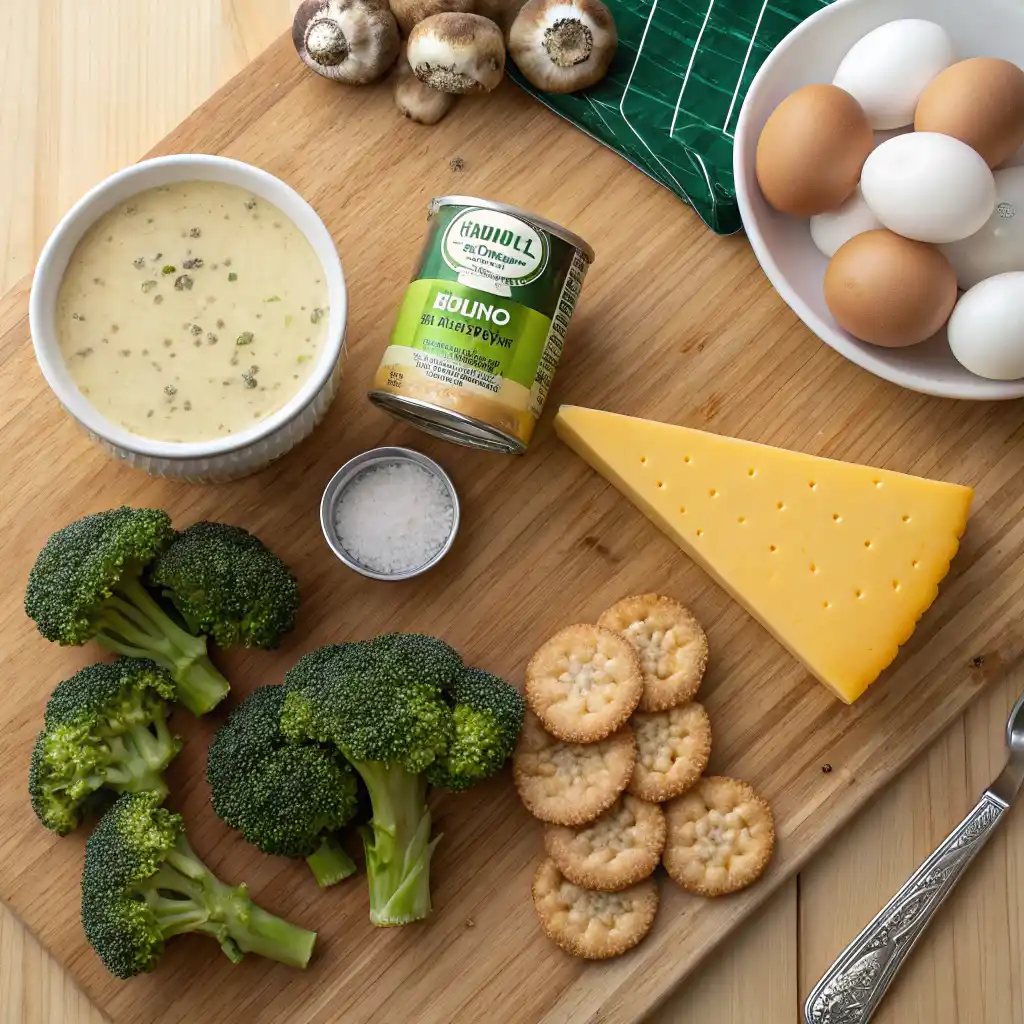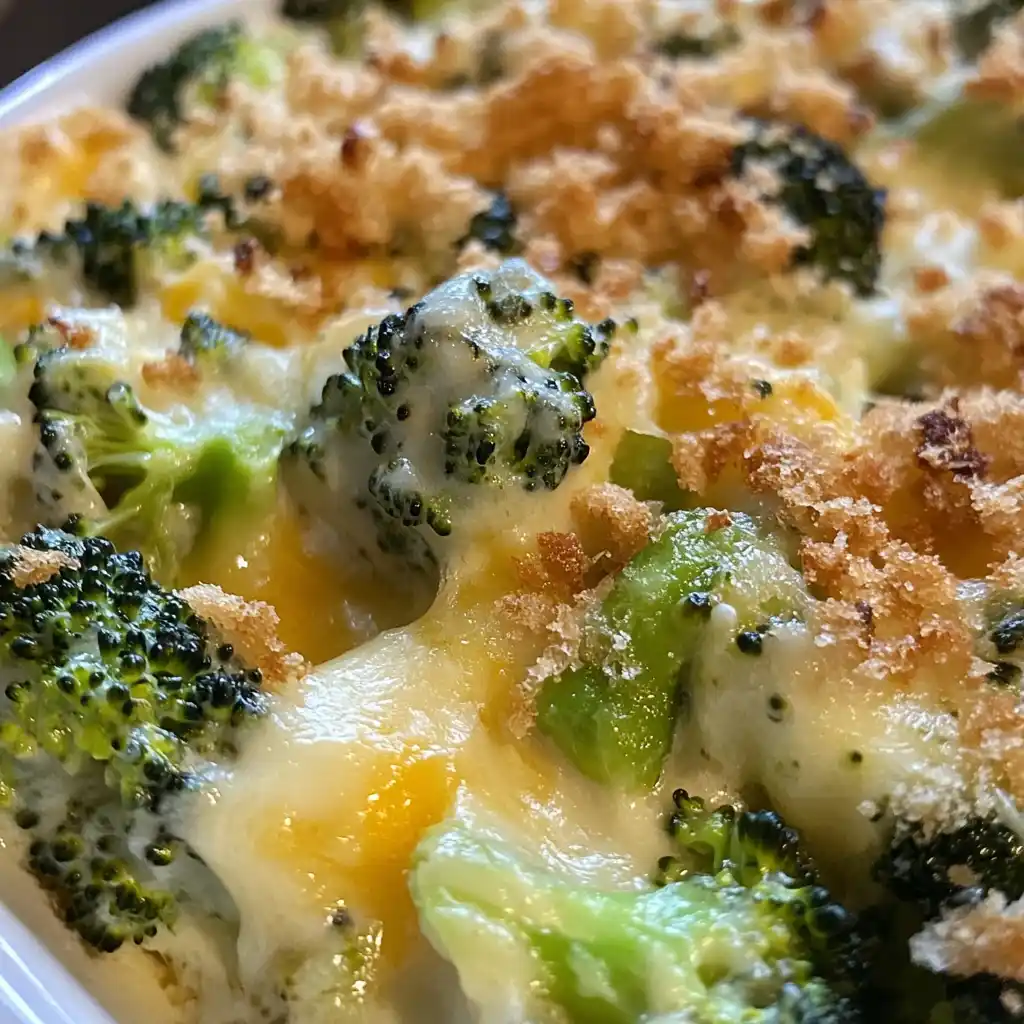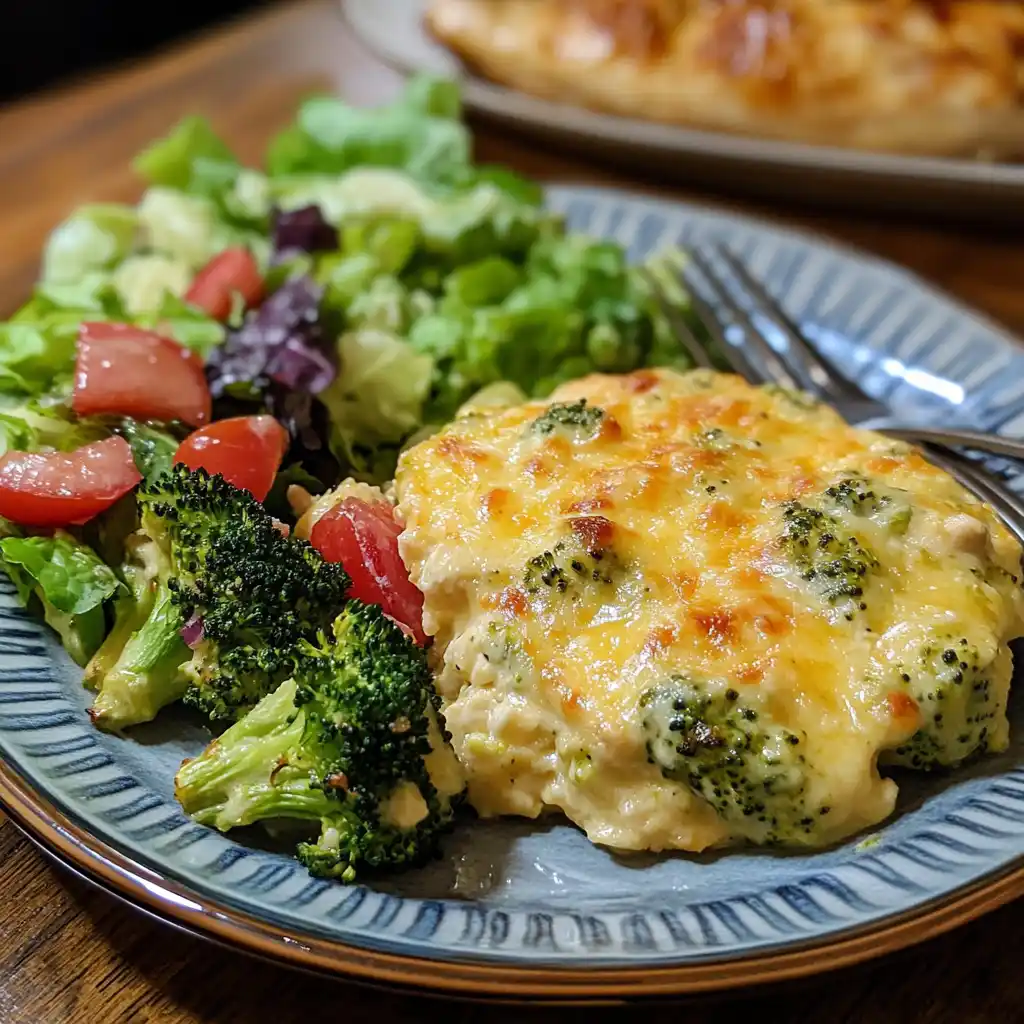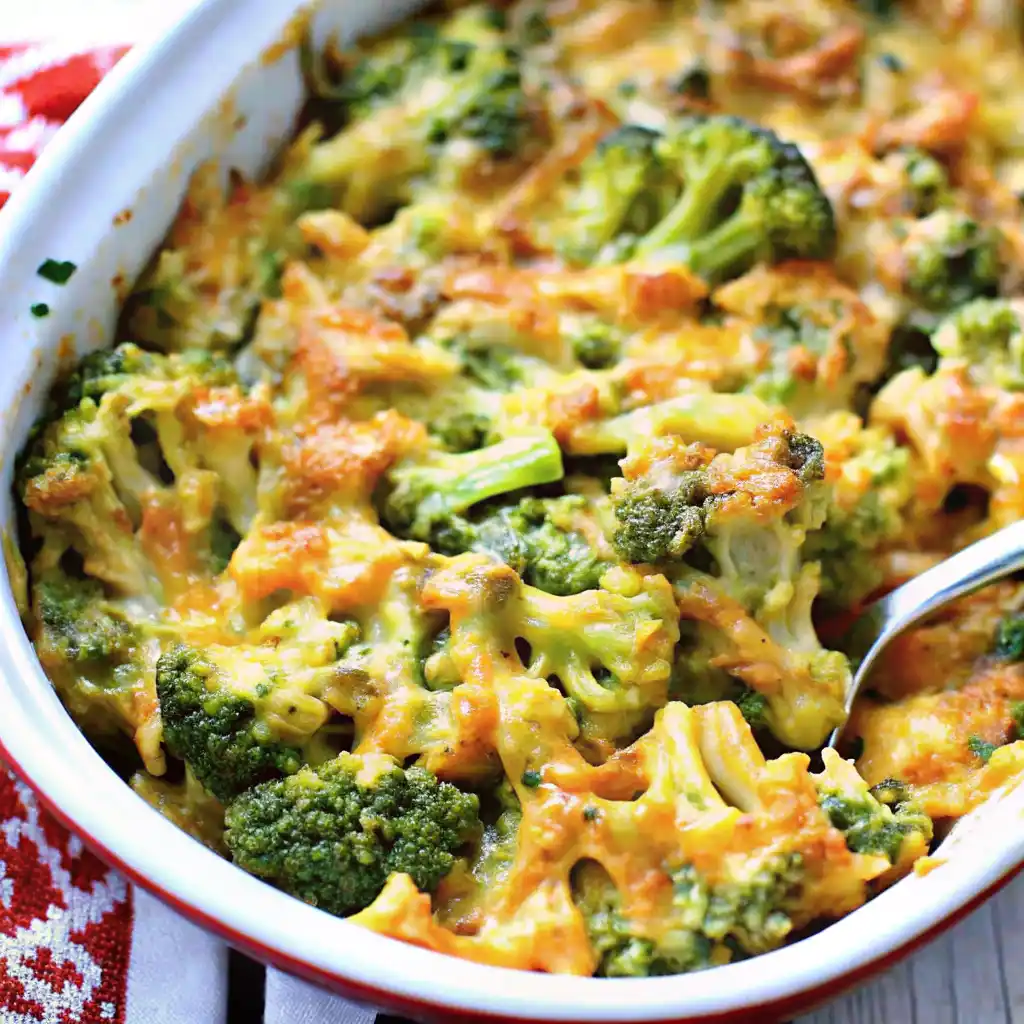Broccoli cheese casserole is the ultimate comfort food—creamy, cheesy, and always a crowd-pleaser. Whether you’re planning a holiday feast, a weeknight dinner, or a potluck side dish, this classic bake delivers every single time. With tender broccoli, rich melted cheese, and a crunchy golden topping, it’s no wonder this dish has earned its place on dinner tables across America.
In this guide, we’ll break down everything you need to know to master broccoli cheese casserole at home. You’ll learn which ingredients work best, how to avoid common problems like a watery texture, and how to customize the dish for holidays, kids, or healthier eating. We’ll also explore famous versions like Paula Deen’s broccoli casserole, uncover what sets them apart, and share step-by-step instructions for building your own from scratch—even without canned soup.
Table of Contents
PART 1: What Is Broccoli Cheese Casserole?
Classic Origins of Broccoli Cheese Casserole
Broccoli cheese casserole is a timeless American comfort food that has graced dinner tables for generations. It first gained popularity in the mid-20th century when casseroles became household staples, praised for their affordability, ease, and versatility. The combination of broccoli, cheese, and creamy soup offered a practical way to stretch ingredients and feed a crowd.
While no single person is credited with inventing the dish, it evolved alongside other favorites like green bean casserole and tuna noodle bake—often built around canned goods and pantry staples. Today, broccoli cheese casserole remains a favorite not only for its nostalgic flavors but also for how easy it is to adapt for modern kitchens and diverse diets.
From Southern kitchens to weeknight family dinners, this casserole continues to be a go-to side that satisfies even the pickiest eaters. Its creamy texture, cheesy goodness, and pop of green from the broccoli make it both comforting and (slightly) nutritious.
Why It’s a Staple Side Dish (or Main)
There’s a reason broccoli cheese casserole shows up at so many occasions—from Thanksgiving spreads to weekday dinners. It hits that perfect balance of being simple to make, hearty enough to satisfy, and rich in flavors that complement nearly any protein or entrée.
Here’s why it’s so popular:
- Crowd-friendly: One dish serves 6–10 people with ease
- Make-ahead ready: Assemble and refrigerate before baking
- Customizable: Easy to adapt for keto, gluten-free, or vegetarian diets
- Comfort in every bite: Cheesy, creamy, and savory with every forkful
- Versatile pairing: Goes well with roasted meats, soups, or salads
Many people also turn it into a main dish by adding chicken, ham, or ground turkey, creating a full meal in one pan.
PART 2: Ingredients You Need for Broccoli Cheese Casserole
What Ingredients Go in Broccoli Casserole?

The heart of any delicious broccoli cheese casserole lies in the simple, comforting ingredients that bring it together. While versions may vary, most recipes rely on a creamy base, a generous helping of cheese, and of course, perfectly cooked broccoli. Here’s what you’ll typically find in a classic broccoli casserole:
| Ingredient | Purpose |
|---|---|
| Broccoli (fresh or frozen) | The star of the dish—provides texture, color, and fiber |
| Cheddar cheese (shredded) | Rich, melty flavor that defines the casserole |
| Cream of mushroom or chicken soup | Adds creaminess and body to the base sauce |
| Eggs | Help bind the casserole and give it structure |
| Mayonnaise or sour cream | Adds tang and moisture |
| Butter | Enriches the flavor and helps brown the top |
| Ritz crackers or breadcrumbs | Create a crispy topping |
| Onion or onion powder | Adds aromatic depth (optional but common) |
| Garlic or seasoning blends | Elevates flavor (Dan-O’s, salt, pepper, paprika) |
Optional Add-ins:
- Velveeta cheese for extra creaminess
- Mozzarella or Monterey Jack for a stringier melt
- Chopped ham, chicken, or bacon to turn it into a main dish
Fresh vs. Frozen Broccoli: Which Works Best?
One of the most common questions when making broccoli cheese casserole is whether to use fresh or frozen broccoli. The good news? Both work—you just need to handle them properly.
Using Fresh Broccoli:
- Offers better texture and vibrant color
- Requires blanching before baking to soften slightly
- Avoids extra moisture that can make the dish watery
Using Frozen Broccoli:
- More convenient and budget-friendly
- Best if thawed and squeezed dry before adding
- Works great in casseroles that bake for longer
Quick Tip: If using frozen broccoli, pat it dry with a paper towel after defrosting. Too much moisture is a common cause of soggy casseroles.
PART 3: How to Make the Best Broccoli Cheese Bake
Step-by-Step Instructions for a Creamy, Cheesy Casserole
Making a rich and gooey broccoli cheese casserole doesn’t require fancy techniques or hard-to-find ingredients. Whether you’re serving it at a family dinner or a holiday gathering, this simple process guarantees golden, cheesy perfection.
Here’s a classic version using canned soup and cracker topping:
Ingredients:
- 4 cups broccoli florets (fresh or frozen, prepped)
- 1 can (10.5 oz) cream of mushroom soup
- 1 cup shredded sharp cheddar cheese
- ½ cup mayonnaise or sour cream
- 2 eggs, beaten
- 1 tsp garlic powder
- ½ tsp black pepper
- 1 sleeve Ritz crackers, crushed
- 2 tbsp melted butter
Instructions:
- Preheat oven to 350°F (175°C) and lightly grease a 9×13-inch baking dish.
- Prepare the broccoli: If using fresh, blanch in boiling water for 2 minutes and drain. If using frozen, thaw and pat dry.
- Make the base mixture: In a large bowl, combine the soup, mayonnaise, eggs, cheese, garlic powder, and black pepper.
- Stir in the broccoli, mixing to coat everything evenly.
- Transfer to the baking dish and spread evenly.
- Top with crushed crackers mixed with melted butter.
- Bake for 35–40 minutes, or until hot and bubbly with a golden crust.
Optional Garnish: Sprinkle with chopped parsley or a dash of paprika for color.
How to Make a Broccoli Cheese Bake Without Soup
Want to skip the canned stuff and keep things a little more homemade? You can absolutely make a delicious broccoli cheese bake without condensed soup—and the results are just as creamy.
Here’s a quick homemade version of the sauce:
Ingredients for No-Soup Sauce:
- 2 tbsp butter
- 2 tbsp all-purpose flour
- 1 cup milk
- ½ cup heavy cream or more milk
- 1½ cups shredded cheddar cheese
- Salt, pepper, and garlic powder to taste
Steps:
- In a saucepan, melt the butter over medium heat.
- Whisk in the flour and cook for 1 minute to create a roux.
- Slowly whisk in the milk and cream, stirring constantly until it thickens.
- Add the cheese and seasonings, stirring until smooth and creamy.
- Mix with your cooked broccoli, eggs, and any extras, then bake as usual.
Why go homemade?
- Lower sodium
- No preservatives
- Richer flavor and better control over texture
PART 4: Famous Versions and Variations
What’s in Paula Deen’s Broccoli Casserole?
When it comes to Southern-style comfort food, Paula Deen’s broccoli casserole stands out as one of the most requested and recreated versions. It’s rich, creamy, and just the right amount of indulgent.
Here’s what sets her version apart:

Ingredients in Paula Deen’s Version:
- 2 (10 oz) packages frozen chopped broccoli, cooked and drained
- 1 cup mayonnaise
- 1 cup shredded sharp cheddar cheese
- 1 (10.5 oz) can condensed cream of mushroom soup
- 2 eggs, lightly beaten
- ½ medium onion, chopped
- Salt and pepper to taste
- Crushed crackers (typically Ritz) for topping
- 2 tbsp melted butter for topping
How it’s made:
Everything (except the topping) is mixed in one bowl, transferred to a casserole dish, and topped with buttered crackers. It’s then baked at 350°F for about 35 minutes until bubbly and golden.
Why people love it:
- The mayonnaise adds unexpected richness and tang
- The onion brings in a savory bite
- It’s a classic holiday side in many Southern homes
Other Popular Recipes (Pioneer Woman, The Kitchn, etc.)
While Paula’s is iconic, there are several other fan-favorite versions of broccoli cheese casserole worth exploring. Each offers a unique spin based on different preferences—some creamier, some cheesier, some with added crunch.
The Pioneer Woman’s Version:
- Uses Velveeta cheese and milk for an ultra-creamy base
- Features round butter crackers for topping
- Great for feeding a crowd, with large batch yields
The Kitchn’s Classic Casserole:
- Leans traditional with cream of mushroom soup and sharp cheddar
- Includes extra onion flavor and uses Ritz crackers
- Emphasizes oven-baked comfort and simplicity
Simply Recipes’ Homemade Approach:
- Focuses on a from-scratch cheese sauce—no cans
- Uses fresh broccoli florets
- A good choice for those avoiding processed ingredients
Whether you like it old-school with Velveeta or gourmet with a homemade béchamel, there’s a broccoli cheese casserole recipe for everyone.
PART 5: Topping and Texture Tips
Choosing Between Crackers, Breadcrumbs, and Cheese
The topping is what transforms your broccoli cheese casserole from simply creamy to irresistibly crunchy and crave-worthy. Whether you go with buttery crackers, golden breadcrumbs, or even more melted cheese, the right topping can take your casserole to the next level.
1. Ritz Crackers (Classic Choice)
- Crushed and mixed with melted butter
- Adds a rich, buttery crunch
- Iconic in Southern-style casseroles (used in Paula Deen and Pioneer Woman’s recipes)
2. Panko or Regular Breadcrumbs
- Great for a lighter, crispier topping
- Can be toasted with olive oil or butter before adding
- Pairs well with garlic powder or Italian seasoning
3. Extra Shredded Cheese
- For a gooey, cheesy crust (especially cheddar or mozzarella)
- Works great when paired with breadcrumbs for a two-texture top
- Melts beautifully and turns golden under high heat
4. Crushed Cornflakes or Potato Chips
- Crunchy and salty, perfect for a twist
- Adds a fun, nostalgic texture layer
- Best added at the end of baking to stay crisp
Pro Tip: Combine 1 cup of your chosen topping with 2 tablespoons of melted butter and sprinkle evenly over the casserole before baking.
Making a Crunchy, Golden-Brown Top
A soggy or pale topping can ruin the visual and textural appeal of your broccoli cheese casserole. Here’s how to guarantee a golden-brown crust every time:
Pre-toast the topping:
- Lightly toast breadcrumbs or crackers in a skillet with butter before adding them to the casserole. This helps lock in crunch, even if your casserole is very moist underneath.
Bake uncovered:
- Covering traps steam, which softens the topping. Always bake your casserole uncovered for the last 15–20 minutes to allow browning.
Use broil at the end:
- For extra crispiness, broil on high for 2–3 minutes after baking. Just keep a close eye to avoid burning.
Mix topping with flavor:
- Add garlic powder, onion powder, paprika, or shredded parmesan to your topping for added flavor and visual appeal.
PART 6: Common Mistakes and Fixes
Why Is My Broccoli Cheese Casserole Watery?
If your broccoli cheese casserole is coming out of the oven soupy, soggy, or just plain watery, you’re not alone. This is one of the most frequent problems home cooks face—and fortunately, it’s also one of the easiest to fix.
Here’s why it happens:
- Excess moisture from broccoli
- Frozen broccoli often releases water during baking. If it’s not fully thawed and dried, that moisture leaks into your sauce and ruins the texture.
- Even fresh broccoli can release water if not blanched or sautéed briefly.
- Too much liquid in the base
- Using too much milk, soup, or sour cream without adjusting thickeners can result in a loose, runny casserole.
- No binding agent
- Eggs and cheese help hold everything together. If you skip them or reduce too much, the dish may fall apart.
- Overbaking
- Overcooking causes ingredients to separate and release water, especially with mayo- or dairy-based recipes.
How to fix it:
- Always drain and dry broccoli well before mixing. If using frozen, pat with paper towels.
- Add 1–2 eggs to bind the casserole together.
- Use cornstarch or flour in homemade sauces to thicken them.
- Let it rest for 10–15 minutes after baking to allow it to firm up before serving.
How to Thicken a Runny Casserole the Right Way
If your casserole already turned out a bit loose, don’t worry—there are ways to bring it back to life or prevent it from happening next time.
Fix it mid-bake (if caught early):
- Carefully remove excess liquid with a spoon or ladle.
- Add a handful of extra shredded cheese or a spoonful of breadcrumbs to absorb moisture.
- Continue baking uncovered to evaporate liquid.
Next time, try this:
- Reduce dairy-based ingredients slightly (like sour cream or mayo).
- Incorporate 1 tbsp of flour or cornstarch into the sauce before baking.
- Use cream cheese or Velveeta for a thicker, meltier texture.
- Always bake uncovered to let steam escape.
Pro Tip: Never skip the “resting” period—letting your broccoli cheese casserole sit before slicing helps it firm up and slice cleanly, just like lasagna.
PART 7: Making It Healthier (Without Losing Flavor)
Low-Carb and Gluten-Free Substitutions
Love broccoli cheese casserole but looking for a lighter version? You don’t have to give up the comfort to cut back on carbs, gluten, or processed ingredients. With a few smart swaps, you can enjoy all the flavor without the extra heaviness.
Low-Carb Casserole Tips:
- Skip crackers or breadcrumbs: Use crushed pork rinds or almond flour for a low-carb topping alternative.
- Use full-fat dairy: Opt for heavy cream, sour cream, or cream cheese instead of milk-based soups for a richer, keto-friendly base.
- Avoid Velveeta and processed cheese: Stick with natural sharp cheddar or Monterey Jack for more flavor and fewer additives.
Gluten-Free Adjustments:
- Use gluten-free cream soups or make your own with cornstarch, milk, and broth.
- Choose gluten-free breadcrumbs or omit entirely for a crust-free version.
- Read labels carefully on mayonnaise, cheeses, and seasoning blends.
Swapping Velveeta and Cream Soups for Real Food
While many classic recipes rely on processed cheese and canned cream soups, it’s easy to create a healthier broccoli cheese casserole from scratch that still tastes amazing.
Homemade Cheese Sauce (no cans, no fillers):
- 2 tbsp butter
- 2 tbsp flour (or gluten-free substitute)
- 1 cup milk or unsweetened almond milk
- 1 cup shredded sharp cheddar
- Season with garlic powder, onion powder, and black pepper
Optional add-ins:
- A spoonful of Greek yogurt or cream cheese for added creaminess
- A splash of chicken broth or vegetable broth to lighten the sauce
- Nutritional yeast for a dairy-free cheesy flavor (great for vegan versions)
Why go homemade?
- Less sodium
- No preservatives
- More control over taste and texture
- Easier to adapt for allergies and dietary preferences
PART 8: Serving Ideas and Storage
What Goes Well with Broccoli Cheese Casserole?
Whether served as a hearty side or a comforting main, broccoli cheese casserole pairs beautifully with a variety of dishes. Its creamy texture and rich cheese flavor make it a natural companion to roasted meats and lighter fare alike.
Here are some crowd-favorite pairings:
| Pairing Option | Why It Works |
|---|---|
| Roast Chicken or Turkey | Classic comfort food pairing |
| Grilled Steak or Pork | Balances rich casserole with bold protein |
| Baked Fish (like cod or salmon) | Adds lightness to the plate |
| Garden Salad | Refreshing contrast to creamy texture |
| Garlic Bread or Dinner Rolls | Helps scoop up every last bite |
| Tomato Soup | Great for lunch with a casserole slice |
For a full vegetarian plate, serve it with a hearty grain like quinoa or brown rice, or a simple soup like butternut squash bisque.
Holiday Pairings:
- Pairs perfectly with ham or prime rib for Christmas
- A great side alongside turkey and stuffing at Thanksgiving
- Can even be served with baked beans and slaw at summer potlucks
How to Store, Reheat, and Freeze Like a Pro
One of the best things about broccoli cheese casserole? It stores and reheats like a dream—perfect for meal prep, leftovers, and holiday planning.
Storage Instructions:
- Let the casserole cool completely before covering.
- Store in an airtight container or wrap the baking dish with foil.
- Refrigerate for up to 4 days.
Reheating Tips:
- Oven: Reheat at 350°F covered with foil for 15–20 minutes. Remove foil for the last few minutes to re-crisp the topping.
- Microwave: Heat individual servings on medium power for 1–2 minutes. Add a splash of milk or cream if it looks dry.
- Stovetop: Gently reheat in a skillet over low heat with a lid on.
Freezing Instructions:
- Assemble but don’t bake for best results.
- Wrap tightly in plastic wrap and foil, then freeze for up to 3 months.
- Bake from frozen at 375°F for 50–60 minutes or until hot in the center.
- You can also freeze individual portions after baking for grab-and-go lunches.

Pro Tip: If freezing, avoid delicate toppings like crushed crackers—they can become soggy. Add them fresh just before baking.
Looking for a protein-packed pairing? Try this high protein egg salad sandwich for a light lunch to balance out a rich casserole dinner.
PART 9: Customizing the Dish for Any Occasion
Turning It Into a Main Dish with Protein Additions
While broccoli cheese casserole is traditionally a side dish, it’s incredibly easy to transform it into a full meal by adding protein. Whether you’re cooking for a family or just want fewer dishes to wash, one-pan casseroles are a game-changer.
Best proteins to add:
| Protein Option | How to Add It |
|---|---|
| Cooked chicken breast | Dice or shred and fold in before baking |
| Ground turkey or beef | Brown, season, and mix in for extra heartiness |
| Chopped ham | Adds saltiness and is great for holiday leftovers |
| Cooked bacon | Sprinkle in crumbled bacon for crunch and smoky flavor |
| Rotisserie chicken | Quick and easy option for busy nights |
How much to add:
- Aim for 1–2 cups of cooked protein, depending on the size of your casserole.
- Mix it in after combining the base ingredients but before topping and baking.
Add a starch for a full meal:
- Cooked rice, quinoa, or pasta can be added to bulk it up further.
- Great for feeding a crowd or stretching leftovers.
Holiday Twists and Kid-Friendly Versions
Broccoli cheese casserole isn’t just for busy weeknights—it’s also perfect for the holidays and even picky eaters when you tailor it right.
Holiday-Friendly Variations:
- Add dried cranberries or toasted nuts for a festive twist
- Use gruyère or smoked cheddar for upscale flavor
- Mix in a splash of white wine or Dijon mustard for sophistication
- Serve in individual ramekins for a classy presentation
Kid-Approved Adjustments:
- Swap broccoli for cauliflower or mix both
- Use mild cheeses like mozzarella or Monterey Jack
- Cut the veggies smaller so they blend in better with the cheese
- Skip onions or strong spices for milder taste
Make it fun: Use cookie cutters to shape the cheese topping or bake in mini muffin tins for hand-held portions. Kids love food that looks snackable!
Frequently Asked Questions About Broccoli Cheese Casserole
What ingredients go in broccoli casserole?
What’s in Paula Deen’s broccoli casserole?
How to make a broccoli cheese bake?
Why is my broccoli cheese casserole watery?
Conclusion
Whether you’re prepping for a holiday feast or a cozy weeknight dinner, broccoli cheese casserole delivers every time. Creamy, cheesy, and endlessly customizable, it’s the kind of dish that brings comfort and smiles to the table.
In this guide, we’ve covered everything from essential ingredients and famous recipe variations to troubleshooting watery casseroles and making the dish healthier. Whether you’re a fan of Paula Deen’s broccoli casserole, craving a quick version with canned soup, or going all-in on a made-from-scratch cheese sauce, you now have all the tools to make it perfect.

